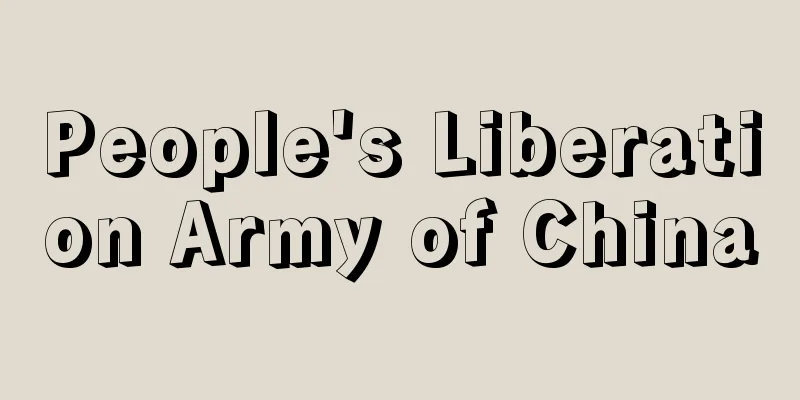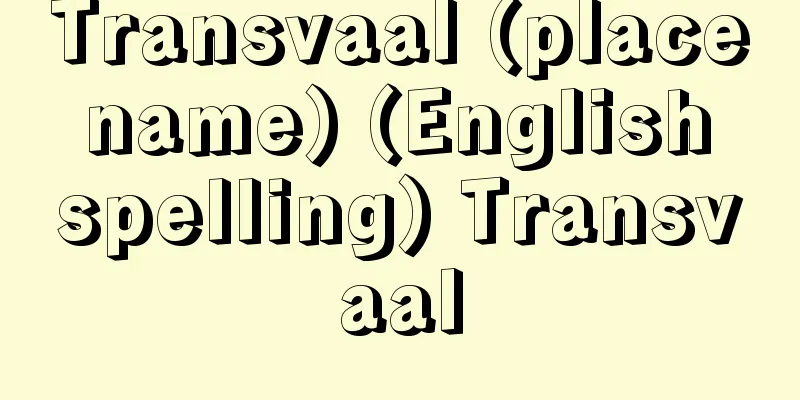People's Liberation Army of China

|
The name of China's military. It is referred to as the "People's Liberation Army of China (hereinafter referred to as the Liberation Army or Army)." As the saying goes, "power is born from the barrel of a gun" (Mao Zedong), the Liberation Army fought against the Nationalist Army as a Communist army and established a Communist state by winning the revolutionary war. Today's Liberation Army is a national defense force responsible for the sovereignty and defense of China, but at the same time it is also the military force of the Communist Party, and politically the party, state, and army are integrated into one trinity. [Ikuo Chihara April 18, 2018] Duties and CharacteristicsThe mission of the PLA is defined as "strengthening national defense, resisting aggression, defending the motherland, defending the people's peaceful activities, participating in national construction, and serving the people" (Article 29 of the Constitution). After the Cold War, China became a great power through rapid economic growth, and the PLA's role in the new strategic environment goes beyond national defense, such as border defense. Furthermore, the concept of territory to be defended has expanded to include the protection of maritime interests and the maintenance of a stable strategic environment for economic development, which has caused frequent friction with related countries over the ocean in the South China Sea and elsewhere. In addition, national integration has been set as a national goal in response to the unification of Taiwan and the movement for separatism and independence of ethnic minorities in the border areas, and such missions have been added. Considering these, the PLA has the following five characteristics. First, it is a national defense force, but at the same time, as a Communist Party army, it is responsible for political maneuvering as the "pillar of the party" to protect the Communist Party's dictatorship and unify the country. Second, due to the history of its establishment, it is considered a founding member of the nation that won the revolutionary war, and even today, politically, the PLA is a powerful power structure in China that ranks alongside the Communist Party. Third, in the relationship between the party and the military, the principle of party supremacy is stipulated that "the party leads the military" (Article 19 of the National Defense Law), and command authority over the military is independent of the state's administrative organs and parliament, and is controlled by the Communist Party and the state's Central Military Commission (independence of supreme command). Fourth, in terms of military force composition, the national defense force is made up of four services (five if the newly established "Strategic Support Force" is included) - the army, navy, air force, and rocket force - and the National Armed Police Force (PAP), making it a two-legged standing army with conventional and nuclear forces. Fifth, the Worker-Peasant Red Army of the Revolutionary War era fought while cultivating farmland, and even today it is an army that carries out traditional production and work tasks, owns real estate, and retains some ability to be self-sufficient. [Ikuo Chihara April 18, 2018] historyHistory of the military establishmentThe predecessor of the Liberation Army was the Worker-Peasant Red Army, which started an armed uprising in Nanchang, Jiangxi Province on August 1, 1927 (the Nanchang Uprising, which later became the anniversary of the founding of the Army). Since then, it has expanded as a military organization through repeated separations and reunions of armed groups that rose up in revolutions in various places. As the civil war with the Kuomintang army continued (the Chinese Civil War), the army was organized as a revolutionary army and fought the revolutionary war in unity with comrades. It was also a highly political army, working hard on productive activities to support itself and expanding its support base mainly in rural areas through political maneuvering. In order to gain the support of a wide range of people throughout the revolutionary war, Mao Zedong imposed "three major disciplines and eight points of caution," such as obeying orders and not stealing from the people, and the army itself strictly adhered to military discipline. As a result, the army won the Chinese Civil War by gaining the trust and support of the people, and came to be nicknamed "the people's children and soldiers." The 1937 Marco Polo Bridge Incident marked the beginning of the War of Resistance against Japan, and the Chinese Civil War was suspended. The revolutionary army was reorganized into the Eighth Route Army and the New Fourth Army, which fought in cooperation with the Chinese Communist Party in the War of Resistance against Japan. During this time, the issue of how the Communist Party could secure dominance over the expanding revolutionary army arose, and at the Furuta Conference (the 9th Party Congress of the 4th Army of the Workers' and Peasants' Red Army in 1929), an order was established in the relationship between the Party and the military, stating that "the Party commands the guns, and the guns should not command the Party." As a system to guarantee this Party dominance, political commissars of equal rank to the commanders (instructors in battalions, instructors in companies, political fighters in platoons, etc.) were appointed to each level of unit, and a "dual command" system of supervision from the Party was born, which continues to this day. The Second Sino-Japanese War ended with Japan's acceptance of the Potsdam Declaration in 1945, but the Chinese Civil War resumed the following year in 1946. The revolutionary army won the "Three Great Battles" of the Liaoshen Campaign, the Huaihai Campaign, and the Pingjin Campaign, and the founding of the People's Republic of China was proclaimed on October 1, 1949. Prior to the founding of the country, the revolutionary army was renamed the "People's Liberation Army" and reorganized into five units, the 1st Field Army, the 4th Field Army, and the North China Corps, and the People's Liberation Army Navy was formed in April 1949. As a result, the Chinese People's Liberation Army Navy was reorganized from the previous armed organizations, which had a variety of military systems, including weapons, equipment, organization, and uniforms, into a military organization with a more or less complete force. However, it still retained the characteristics of a party army and a revolutionary army that fought alongside the party. [Ikuo Chihara April 18, 2018] Transformation and modernization into a national defense forceWith the founding of the People's Republic of China, the revolutionary army was also positioned as the national army under the name "People's Liberation Army of China (Liberation Army)" and was tasked with the defense of the nation. The PLA acquired weapons and equipment from the Soviet Union, as well as military systems such as a rank system, and has since taken on the appearance of a modern military force. The modernization of the PLA continued even after the founding of the nation. In the fall of 1949, the Air Force was established, creating a tri-service structure with army, navy and air force. In 1964, following the first successful nuclear test, the Second Artillery Corps (nuclear and rocket forces) was formed, and the prototype of today's PLA was established. After that, the army first participated in the Korean War in 1950 as a volunteer force, where it received a harsh baptism of fire from the United Nations forces and suffered heavy casualties, forcing it to modernize as a national defense force. During the Mao era, the country experienced chaotic situations such as the Cultural Revolution, and in order to calm the situation, the PLA was given the task of "Three Branch Armies (supporting the left, workers, and peasants, and conducting military control and military training)," and political maneuvering was emphasized, leading to an expansion of military strength. During this stage of national defense modernization, emphasis was placed on politics and revolution, and the military's quantitative expansion was repeatedly cut. During the Deng Xiaoping era, large-scale military reforms were implemented in the National Defense Forces. These were carried out in parallel with the economic reform and opening-up policy, and large-scale troop reductions and modernization were promoted under the policy of "following the overall situation" that prioritized economic construction. Furthermore, learning from the hardships of the 1979 Sino-Vietnamese War, the PLA was modernized, and emphasis was placed on strengthening its military power with a focus on national defense. In the 1980s, a policy was put into place to reduce the number of troops by about one million, and the 11 military regions were reduced to seven. Furthermore, during this period, defense spending was restrained, and economic activity by the military was praised in order to make up for the shortfall in defense spending, which later became an indirect cause of frequent corruption among military personnel. During the military reforms of the Jiang Zemin era (1989-2004), following the Tiananmen Square incident in 1989, emphasis was placed on the PLA's revolutionary character as a Communist Party military, and its function as the "pillar of the party" was strengthened. This marked an era in which a new generation of leaders with no experience of revolutionary war or military history took over as leaders, and with the party's dominance in jeopardy, the rapid increase in defense spending could not be contained, with double-digit increases continuing year-on-year, but in 1997, troop strength was reduced by 500,000. During the Hu Jintao era (2003-2012), modernization aimed at turning the PLA into a national defense force was underway under the unnatural circumstances of Jiang Zemin refusing to relinquish command authority. Nevertheless, the PLA was reformed by reducing the number of troops by 200,000 in 2003, adding the commanders of the Navy and Air Force and the Two Artillery Forces to the Central Military Commission, which oversees the military command, and appointing generals from the Navy and Air Force to the four general departments (the General Political Department, General Logistics Department, and General Armament Department), including the General Staff Department, which was the army's stronghold. In addition, efforts were made to limit the defense budget, which had been increasing continuously, to a 7% increase for the first time in fiscal 2010 after more than 20 years of double-digit increases compared to the previous year. Nevertheless, the Liberation Army remains faced with the traditional dilemma of whether to be a party army or a national army, and furthermore, a revolutionary army or a national defense army, and the modernization of national defense has continued to this day through trial and error. [Ikuo Chihara April 18, 2018] Military situationThe true state of military power is unclear due to a lack of published data, but we will infer and summarize the state of military power from various sources such as The Military Balance , published regularly by the International Institute for Strategic Studies (IISS) in the UK, and Japan's Defense White Paper (as of 2015). (1) Army With a total of 1.6 million troops and 18 combined armies (reduced to 13 combined armies in 2017), China has the world's largest army in terms of quantity. Its main weapons are an overwhelming amount of 15,200 artillery pieces and 7,200 tanks, but in recent years it has been modernized with new weapons such as attack helicopters and Type 99A tanks, strengthening its mobility and air defense firepower. These forces are deployed across the country in five theaters, and are responsible for defense along the world's longest border, which stretches 21,000 kilometers and borders 14 countries, while also playing a role in maintaining domestic stability. (2) Navy With 235,000 personnel and 879 warships of 1.502 million tons, China has the second largest navy in terms of quantity after the United States and Russia. In addition to 63 major surface combatants and 69 submarines, as well as amphibious warships and minesweepers, China has 700 combat aircraft, which are organized into three fleets: the North Sea, the East Sea, and the South Sea. In recent years, China has placed emphasis on its navy, and is modernizing it by commissioning the aircraft carrier Liaoning, building new aircraft carriers, and introducing Aegis ships and YJ-62 anti-ship cruise missiles. Of particular note is the presence of two marine brigades in the South Sea Fleet, which shows China's extraordinary interest in effectively controlling islands in the South China Sea. (3) Air Force With 400,000 personnel and 2,715 combat aircraft, China is the second largest air force in terms of numbers after the United States. For air defense, China possesses 16,000 anti-aircraft guns and many anti-aircraft missile units. China is also modernizing its combat aircraft, including the early warning aircraft "Kong-500," the new long-range bomber "H-6K," and the "J-11B" fighter bomber, and has approximately 400 fourth-generation fighter aircraft. (4) Nuclear Forces It consists of 100,000 troops and nine missile forces of various kinds, with 52 Intercontinental Ballistic Missiles (ICBMs) capable of reaching the US mainland, 160 Inter-Thermal Ballistic Missiles (IRBMs) capable of reaching the surrounding Asian regions, 48 Submarine-Launched Ballistic Missiles (SLBMs), and various delivery methods such as the H-6K bomber, with a total of 260 warheads. These nuclear forces are managed by the newly established Rocket Force, and serve as a deterrent against the US, Russia, and other nations, as well as political and psychological intimidation against neighboring Asian countries. However, China's defense forces are still insufficient to fight the new type of war known as information warfare, which requires digitalization and integrated operations. China also lacks nuclear deterrence against the United States, its greatest threat. There is a great need for new defense modernization in response to the domestic and international strategic environment. [Ikuo Chihara April 18, 2018] Situational awareness and strategy as seen in the Defense White PaperPerception of the security situationHow does China view the security environment surrounding the country? We will summarize its assessment of the situation from the Defense White Paper (2015 edition) published by the Information Office of the State Council of China. Regarding the overall situation, the report states that "the world continues to move toward multipolarity, and the international community is becoming a community of shared destiny due to the progress of economic globalization," and that "while there is no possibility of a world war, the occurrence of small-scale conflicts has become the norm." It also lists "hegemonism, authoritarianism, and new interventionism," referring to the United States, as threats to China's security, and specifically warns of the United States' rebalancing strategy, which would see the United States intervene in the South China Sea situation despite being an extra-regional power. It also sees countries such as Vietnam and the Philippines as challenging China's maritime interests. Furthermore, it lists the unstable situation on the Korean Peninsula, the rampant threat of terrorism, separatism, and extremism, a domestic crisis that could affect national integration, and the emergence of provocations against overseas interests as regional threats. Regarding weapons, the report believes that the military revolution is progressing and that "revolutionary changes in military technology and warfare patterns are posing a challenge to China's military security," and while it places importance on "long-range precision guidance, smart, stealthy, unmanned systems, and the combatization of outer space and cyberspace," it recognizes that China is lagging behind in these areas. At the same time, it also recognizes the existence of complex threats to national integrity within the country (Taiwan, Uyghur, Tibet). Overall, China is not optimistic about its security environment, as it believes that its security still faces many threats today. [Ikuo Chihara April 18, 2018] Military strategyBased on this understanding of the situation, the Defense White Paper states that the military's mission is "(1) to safeguard the social system under the leadership of the Communist Party, (2) to be a guarantor of the realization of a moderately prosperous society and the great rejuvenation of the Chinese nation." Furthermore, the PLA's "strategic missions" are listed as "(1) to respond to emergencies and military threats, (2) to safeguard the security of the nation's territory, airspace, territorial waters, and sovereignty, (3) to safeguard the unity of the motherland, (4) to safeguard new types of security and interests, (5) to safeguard overseas interests, (6) to strengthen strategic deterrence and counterattack capabilities, (7) to cooperate in regional and global security, (8) to strengthen counter-infiltration (preventing infiltration and incitement of ideas that undermine China's national polity), anti-secession, and anti-terrorism efforts, and to safeguard the nation's political and social security, and (9) to support disaster relief, protection of overseas interests, security, and national economic and social construction," clearly demonstrating the PLA's character as a party military that supports the Communist Party's governance. Regarding China's military strategy, the Defense White Paper first states that the "active defense strategy under modern conditions" is the "basic point of the Communist Party's military strategy," positioning it as the basic national defense strategy to defend the sovereignty, unity, and security of the nation's territory. It explains that the basic stance is based on the keywords "defense, self-defense, and delayed counterattack (no preemptive attacks, but sure to retaliate if attacked)." The paper interprets the "active defense strategy under modern conditions" as a strategy that emphasizes victory in local battles under informationized conditions, as informationized warfare has become mainstream in this century. In the service strategies, which are subordinate to the National Defense Strategy, the Army strategy calls for a "shift from regional defense to all-area mobile defense," and declares a shift from defense based on regional deployment to a strategy that pursues early strikes through the joint operation of mobile forces. The naval strategy has been shifted from a coastal defense strategy that pursued defense of the sea area up to the first island chain (the line connecting the Nansei Islands, Taiwan, and the Philippines) to a "combined coastal defense and deep seas escort strategy," and defense of the sea area expanded to the second island chain (the line connecting the Ogasawara Islands and Guam) is being pursued. The US military regards this as an anti-access/area denial (A2/AD) strategy, and sees it as an expansion of China's defense zone in front of the ocean. The air force strategy has shifted from a national air defense strategy of intercepting air attacks on Chinese territory both inside and outside its airspace to a "combined offensive and defensive strategy," and has become an aggressive strategy that not only intercepts attacks but also simultaneously strikes enemy bases (sources of attack). The nuclear strategy of strategic nuclear missile forces has been described as a "minimal nuclear deterrence strategy" due to the low survivability of counterattack capabilities against a first-strike. However, the reliability of counterattack capabilities has increased through the strengthening of various nuclear delivery methods, the strengthening of the power of SLBMs, and the improvement of their stealth, and so a "strategic deterrence/nuclear counterattack strategy" has come to be touted. Furthermore, the importance of "medium- to long-range precision guidance capabilities" is being emphasized in order to strengthen deterrence. [Ikuo Chihara April 18, 2018] Xi Jinping's Military ReformsBased on the above-mentioned Chinese situation recognition, the military mission and military strategy of the new era, military reform is being promoted under the Xi Jinping administration. The so-called "Xi Jinping military reform" was proposed as part of the important "Comprehensively deepening reform" resolution adopted at the Third Plenary Session of the 18th CPC Central Committee in the fall of 2013. Xi Jinping's first words immediately after assuming the post of Chairman of the Central Military Commission in November 2012 were, "We need an army that will come when called, fight when called, and win when it fights." The key points of Xi Jinping's military reform are not only to build a modern army that can win in informationized warfare, but also to establish the party's superiority in the relationship between the party and the military as a top leader of the new generation. This can be summarized in the keywords "the Central Military Commission supervises everything, the theater command the operations, and the military is in charge of military construction." Specific items of the military reform, as stated in the Liberation Army Daily (dated December 28, 2015) and elsewhere, include: (1) building an army that can win under information warfare conditions, (2) implementing groundbreaking reforms towards a joint operational command system, (3) reorganizing and streamlining military regions into theater command centers and restructuring each service, including the Second Artillery Corps, into a joint force by 2020, (4) emphasizing operational capability and promoting military modernization that "emphasizes quality and efficiency over quantity and scale," and (5) reducing troop strength by 300,000 in relation to this. Other areas targeted for reform include the development of professional military personnel, practical training, and management of the military budget and rear-office functions. [Ikuo Chihara April 18, 2018] First reform: Establishment of three new institutionsIn the military reform, a large-scale reform of the military organization was promoted in three stages. Specifically, the first step was the creation of three organizations at the end of 2015: the Army Guidance Organization (Command), the Rocket Force, and the Strategic Support Force. This reform shows the "service-based construction," and the establishment of the Army Command has created a command center to oversee the large army with 1.6 million personnel. However, this means that the army will be treated as a service alongside the navy and air force, and conversely, the status of the army will be lowered, which may lead to pent-up discontent within the army. The Rocket Force inherits the mission and organization of the strategic nuclear missile unit of the Second Artillery Corps, and has been officially promoted to a service. Furthermore, the newly formed Strategic Support Force is a unit responsible for information, including space, and cyber-related matters, and has become an important unit equivalent to a service as a new operational force to protect national security. [Ikuo Chihara April 18, 2018] The second reform: Dismantling and reorganization of the four general departmentsAs the second military reform, in January 2016, a major axe was swung to reorganize the so-called four general departments - the General Staff Department, General Political Department, General Logistics Department, and General Armaments Department - which were directly linked to the Central Military Commission and boasted great authority, in order to realize the "General of the Military Commission" system. As a command structure, the "Joint Staff Department", which will stand at the top of operational management and replace the General Staff Department, will be made the core department, and some bureaus within the former General Staff Department will be separated and made into the "Training Management Department" and "Defense Mobilization Department", as well as the "Strategic Planning Office" and "Organization and Reform Office", which will be independent and elevated to the same ranks. In addition, some functions of the General Political Department were removed and reorganized into the "Political Work Department," the General Logistics Department, which was responsible for rear logistics operations and accounting, was reorganized into the "Logistics Security Department," and the General Armament Department, which was responsible for the development and management of weapons and equipment, was reorganized into the "Equipment Development Department," and the functions of the four enormous general departments were divided. Additionally, committees such as the "Commission for Discipline Inspection," responsible for enforcing discipline within the military, were separated from the former General Political Department and a new group of direct committees was formed, which was then separated from the former General Political Department. Furthermore, the "Accounting Office" from the General Logistics Department was placed directly under the Military Commission, strengthening its accounting and auditing functions and becoming a direct staff organization. Overall, the second reform split up and reorganized the military power of the four powerful general departments, promoting the "establishment of a leadership position in the party," and also demonstrating the extent to which Chairman Xi has control over the military. [Ikuo Chihara April 18, 2018] The third reform: the reorganization of "theater zones"As the third military reform, "theater commands" were newly established with the aim of "strengthening actual combat power." The organization of "theater commands," a joint force necessary for joint operations, eliminated the cumbersome military district system linked to local governments. (1) The Eastern Theater Command, the largest of the three, is a theater command centered on the former Nanjing Military Region, and is responsible for the liberation of Taiwan, the East China Sea, and the Pacific Ocean, and is responsible for important fronts. (2) The Southern Theater Command is centered on the former Guangzhou Military Region, and is responsible for the South China Sea front and the front of Southeast Asian countries such as Vietnam. (3) The Western Military Command is a theater command that covers a part of the former Chengdu Military Region and a wide area of the Lanzhou Military Region, and is responsible for dealing with India and the vast Eurasian continent related to the Silk Road strategy. (4) The Northern Theater Command is the former Shenyang Military Region and most of the Jinan Military Region, and is responsible for the front of North Korea and the front of Russia and Mongolia. (5) The Central Theater Command is part of the former Jinan Military Region in addition to the capital defense of the former Beijing Military Region, and is expected to play the role of capital defense and central strategic reserve. Furthermore, operational command is passed down from the Joint Staff to the Theater Joint Operations Command via the Joint Operations Command Center under the Central Military Commission, reducing command hierarchies and enabling speedy operational command. Going forward, Xi Jinping's military reforms are expected to be broad-based, from weapons modernization to military systems and training. However, with relations between the party and the military still in turmoil, it will remain to be seen how thoroughly the unified military will be implemented. [Ikuo Chihara April 18, 2018] The future of the PLA and its challengesChina, which has set the slogan "Restoring Great China," has achieved economic growth and is a permanent member of the United Nations Security Council with veto power, and has a strong desire to possess military power worthy of a great power. What role will China play in maintaining global security and stability and international order in the future, and how will the PLA's position and function be exercised in that regard, are attracting attention. Today, the military reform and modernization being carried out toward 2020 aims to modernize weapons and equipment in response to the progress of the global military revolution, and to build an operational system that can exert joint forces in response to the new warfare known as informationized warfare. At the root of China's view of security is the humiliating historical experience of being semi-colonized after losing the Opium Wars, the trauma of "if you don't have power, you will be defeated," and the tendency to believe in power, which is why they place importance on the military and strong power to protect the security of the country. However, up until now, defense spending and expenses related to national security have been considered sacred cows, but as the Chinese economy begins to show signs of decline, attention will be focused on the extent to which the allocation of national resources to security will be prioritized. The PLA is still faced with the dilemma of whether it is the army of the state or the army of the party, and it continues to face the dilemma of how to win the information war of the new era and how to play a role in supporting the Communist Party's rule under the changing domestic political situation. How the PLA, which has become a powerful power structure, will be politically controlled in the context of its unique history of establishment and traditional view of security will remain an important issue. In particular, while the principle of civilian control is established in democratic countries regarding the command of armed groups, in China, under the Communist Party's ruling system, the nature of the command authority of the PLA, the "pillar of the party" that supports it, is a major theme that also relates to party-military relations. The behavior of the PLA, which has become an even more powerful power structure, has led to its influence in the South China Sea today, and has led to international concerns that China is "changing the status quo through force." [Ikuo Chihara April 18, 2018] [References] | | | |Kuomintang- | | | | |Sino | | | | | |©Shogakukan "> The chain of command of the People's Liberation Army after reform ©Shogakukan "> Chinese military deployment and strength Source: Shogakukan Encyclopedia Nipponica About Encyclopedia Nipponica Information | Legend |
|
中国の軍隊の名称。「中国人民解放軍(以下、解放軍または軍)」と呼称されている。解放軍は、「政権は銃口から生まれる」(毛沢東(もうたくとう))といわれるように、共産党軍として国民党軍と戦い、革命戦争に勝利することで共産党国家を打ち立てた。今日の解放軍は中国の主権と国家の防衛を担う国防軍であるが、同時に共産党の軍隊でもあり、政治的には党・国家・軍は三位(さんみ)一体化している。 [茅原郁生 2018年4月18日] 任務と特性解放軍の任務は「国防を強化し、侵略に抵抗し、祖国を防衛し、人民の平和な活動を防衛し、国家の建設事業に参加し、人民に奉仕する」(憲法第29条)と規定されている。冷戦後、中国は高度経済成長により大国となり、新しい戦略環境下での解放軍の役割は国境守備などの国家防衛にとどまらない。さらに海洋権益の擁護、経済建設のための安定した戦略環境の保持など、防衛すべき領域概念は拡大しており、南シナ海などで海洋をめぐる関係国との摩擦を多発させている。また台湾統一や辺境の少数民族の分離独立の動きに対して国家統合が国家目標に掲げられており、そうした任務も付加されている。 これらを踏まえて解放軍の特性としては、以下の五つがあげられる。第一に国家の防衛軍であると同時に共産党軍として共産党独裁体制の護持や国家の統合のために「党の柱石」として政治工作任務を担っている。第二に建軍の経緯から革命戦争に勝利した建国の功労者に位置づけられ、今日でも解放軍は政治的には共産党と並ぶ中国の強大な権力機構である。第三に党軍関係では「党が軍を領導する」と党優位の原則(国防法第19条)が規定されており、軍隊に対する指揮権は国家の行政機関や議会から独立して、共産党および国家の中央軍事委員会によって統率されている(統帥権の独立)。第四に戦力組成上から、陸・海・空・ロケット軍の4軍種(新設の「戦略支援部隊」を含めれば5軍種)および国家武装警察部隊(武警)からなる国防軍で、通常戦力と核戦力の2本足の常備軍である。第五に革命戦争時代の労農紅軍(こうぐん)は農地を耕しながら戦った過程を経ており、今日でも伝統的な生産工作任務を担い、不動産を有し、一部の自活能力を保持する軍である。 [茅原郁生 2018年4月18日] 歴史建軍の経緯解放軍の前身は1927年8月1日に江西省南昌において武装蜂起(南昌暴動。のちに建軍記念日となる)した労農紅軍であり、以来各地で革命に蜂起した武装グループが集散離合を繰り返しながら拡大した軍事組織である。国民党軍との内戦(国共内戦)を続けるなかで革命軍として組織を整え、同志的な結合のなかで革命戦争を戦った。また、自活のための生産活動に励み、政治工作によって農村を中心に支持基盤を拡大するなど政治性の強い軍隊であった。革命戦争時代を通じて広範な人民の支持を得るために、命令には従う、人民のものは盗まないなどの「三大規律・八項注意」が毛沢東によって課せられ、自ら厳しく軍律を守った。それにより民衆の信頼と支持を得て国共内戦に勝利するとともに「人民の子弟兵」と愛称されるようになった。 1937年の盧溝橋(ろこうきょう)事件から抗日戦争が始まったのを契機に国共内戦を中断して、革命軍は八路(はちろ)軍、新四軍に改編され、国共合作して抗日戦争を戦った。この間に膨張する革命軍に対して共産党が優位を確保する問題が浮上し、古田(こでん)会議(1929年の労農紅軍第4軍第9次党代表大会)で「党が鉄砲を指揮するのであって、鉄砲が党を指揮してはならない」という党軍関係の秩序が確立した。この党優位を保証する制度として、各級の部隊には指揮官と並ぶ同格の政治委員(大隊では教導員、中隊では指導員、小隊では政治戦士など)が設置されて、党から監視する「二元指揮」制度が生まれ、今日に至っている。 日中戦争は1945年の日本のポツダム宣言受諾に伴い終わったが、翌1946年から国共内戦が再発。遼瀋(りょうしん)戦役、准海(わいかい)戦役、平津(へいしん)戦役の「三大会戦」で革命軍が勝利して、1949年10月1日に中華人民共和国の建国が宣言された。建国に先だち、革命軍は「人民解放軍」と改名され、第1野戦軍から第4野戦軍までと華北兵団の5個部隊に整理統合されるとともに、1949年4月には人民解放軍海軍が新編された。これにより兵器装備から組織や軍服などの軍制もまちまちであった従来の武装組織から、一応隊容の整った軍事組織に整備された。それでも党とともに戦う党軍、革命軍の特性を色濃く保持していた。 [茅原郁生 2018年4月18日] 国家防衛軍への変身と近代化建国を契機に、革命軍は「中国人民解放軍(解放軍)」として国軍にも位置づけられ、国家防衛を担うこととなった。解放軍はソ連から取得した武器・装備や階級制度などの軍制を導入して近代軍の隊容を整えてきた。建国後も解放軍の近代化は続けられた。1949年秋には空軍を創設して陸海空の三軍体制を整え、1964年には核実験初成功に伴って第2砲兵部隊(核部隊・ロケット軍)の新編などにより今日の解放軍の原型は整った。 その後は、まず1950年には朝鮮戦争に志願軍として参戦し、国連軍から手痛い近代戦の洗礼を受け、多大な犠牲を払ったことにより国防軍としての近代化を迫られてきた。 毛沢東時代には文化大革命など国内が混乱する事態が生まれ、その沈静化のために解放軍に「三支両軍(左派・労働者・農民を支持し、軍事管制・軍事訓練を行う)」任務が課せられるなど政治工作が重視され、兵力は膨張した。この段階の国防近代化は政治性や革命性が重視され、量的に膨れあがった軍兵力の削減などが反復されていた。 鄧小平(とうしょうへい)時代には国防軍に向けて大規模な軍事改革が断行された。それは経済の改革開放政策と併行して進められ、経済建設を優先する「大局に従う」方針のもとで大規模な兵力削減と近代化が進められた。また1979年の中越戦争での苦戦が教訓とされて解放軍の近代化は進められ、国家防衛を主眼に戦力強化が重視された。1980年代には約100万人の兵力削減が政策的に進められ、11個の軍区は7軍区に縮小された。さらにこの時期には国防費は抑制され、不足する国防費を補填(ほてん)するために軍隊の経済活動が称揚され、のちに頻発する軍人の汚職腐敗などの遠因となった。 江沢民(こうたくみん)時代(1989~2004)の軍事改革は、1989年の天安門事件を経て、解放軍には共産党軍としての革命性が重視されて「党の柱石」機能が強化された。革命戦争の経験や軍歴のない新世代が指導者となる時代となり、党優位が揺らぐなかで国防費の急増を抑えきれず、前年比で2桁(けた)の増額が続いたが、1997年には50万人の兵力が削減された。 胡錦濤(こきんとう)時代(2003~2012)は、江沢民が統帥権を手放さない不自然な状況下で国防軍化を目ざす近代化が進められた。それでも2003年の20万人の兵力削減や軍統帥をつかさどる中央軍事委員に海・空軍司令員や2砲司令員を加え、また陸軍の牙城(がじょう)であった総参謀部をはじめとする四総部(ほかに総政治部、総後勤部、総装備部)にも海・空軍などの将軍を登用して陸軍中心の解放軍に改革のメスが入れられてきた。また増額が続く国防費についても、20年以上続いた前年比2桁増を2010年度に初めて7%増に抑え込む努力もみられた。 それでも解放軍は党軍か、国家の軍隊か、さらに革命軍か、国防軍かの二つの伝統的なジレンマを抱えたまま、国防近代化は試行錯誤的に今日まで続けられている。 [茅原郁生 2018年4月18日] 軍事力の状況軍事力の実態は公表資料が不足して不透明であるが、イギリスの国際戦略研究所(IISS)が定期発行している『ミリタリー・バランス』The Military Balanceや日本の『防衛白書』などの諸資料から軍事力の状況を推測・要約しておこう(2015年時点)。 (1)陸軍 総兵力160万人で18個の合成集団軍(2017年に13個集団軍に削減改編)を中心に、量的には世界最大規模の陸軍力を擁している。主要兵器としては火砲を1万5200門、戦車を7200両保有する圧倒的な兵器量であるが、近年攻撃ヘリや99A式戦車など新兵器への近代化が進み、機動力や防空火力が強化されている。これら戦力は、全国土に展開する5個の戦区が14か国と国境を接する2万1000キロメートルにわたる世界最長の国境線で防衛に任じるとともに、国内安定の役割を担っている。 (2)海軍 兵力23万5000人、150万2000トンの戦闘艦879隻を擁し、量的には米ロに次ぐ大海軍力を保有している。主要な水上戦闘艦63隻、潜水艦69隻、さらに両用戦闘艦や掃海艦などのほかに作戦機700機を有し、これらは北海、東海、南海の3個艦隊に組み込まれている。近年、海軍重視が強調され、空母遼寧号の就役や新たな空母建造、イージス艦やYJ-62対艦巡航ミサイルなどの導入により近代化が進められている。特筆すべきは南海艦隊に2個海兵旅団を擁していることで、南シナ海島嶼(とうしょ)の実効支配への並々ならぬ関心をのぞかせている。 (3)空軍 兵力40万人、作戦機2715機を擁し、数的にはアメリカに次ぐ大空軍力である。防空力としては高射砲1万6000門や多くの対空ミサイル部隊を保有している。早期警戒機「空警-500」、新型長距離爆撃機「H-6K」や「殲(せん)11B」戦闘爆撃機など作戦機の近代化も進められており、第4世代戦闘機は約400機に上る。 (4)核戦力 兵力10万人、9個の各種ミサイル軍からなり、アメリカ本土まで届く大陸間弾道弾(ICBM)52基、アジア周辺地域を射程に収める戦域弾道弾(IRBM)160基、潜水艦発射ミサイル(SLBM:Submarine-Launched Ballistic Missile)48基、さらにH-6K爆撃機など多様な運搬手段を保持し、弾頭数は260発を保有している。これら核戦力は新編のロケット軍が管理し、米ロなどに対する抑止力とともにアジア近隣諸国への政治・心理的威圧効果を発揮している。 しかし中国は、デジタル化し統合運用が求められる情報化戦争といわれる新しい戦争を戦い抜くにはまだ不十分な体制であり、また最大脅威であるアメリカに対する核抑止力にも不足があり、国内外の戦略環境に応じた新しい国防近代化の必要性は大きい。 [茅原郁生 2018年4月18日] 『国防白書』にみる情勢認識と戦略安全保障上の情勢認識中国は自国を取り巻く安全保障環境をどうみているか、その情勢認識を中国国務院新聞弁公室が発行した『国防白書』(2015年版)から整理する。 全般情勢については「世界は多極化の趨勢(すうせい)が続き、経済のグローバル化の進展で国際社会は運命共同体化している」とみて、「世界大戦の可能性はないが小規模紛争の生起が常態化した」と分析している。また中国の安全に対する脅威としてアメリカをさす「覇権主義、強権政治、新干渉主義」をあげ、具体的にはアメリカのリバランス(再均衡)戦略で、アメリカが域外勢力でありながら南シナ海事態へ介入することなどを警戒している。そしてベトナムやフィリピンなどは中国の海洋権益に挑戦しているとみている。さらに地域の脅威として朝鮮半島の不安定な情勢、テロリズム・分裂主義・過激主義の猛威、国家統合にかかわる国内危機、海外利益に対する挑発の顕在化などもあげている。 また兵器については、軍事革命が進展し「軍事技術と戦争形態の革命的変化は中国の軍事安全への挑戦となっている」とみて、「長距離精密誘導化、スマート化、ステルス化、無人化などや宇宙空間とサイバー空間の戦力化」を重視しながらも、この面での中国の遅れを認識している。同時に国内にある国家統合に対する複雑な脅威の存在(台湾、ウイグル、チベット)も認識している。総じて中国の安全は今日、なお多くの脅威に直面しているとして安全保障環境を楽観してはいない。 [茅原郁生 2018年4月18日] 軍事戦略このような情勢認識にたって先の『国防白書』は、軍隊の使命について「(1)共産党の指導下で社会制度を守る、(2)小康社会実現と中華民族の偉大な復興の保証力となる」としている。さらに解放軍の「戦略的任務」について「(1)突発事案や軍事的脅威への対処、(2)国家の領土、領空、領海や主権の安全を守る、(3)祖国の統一を守る、(4)新タイプの安全と利益を守る、(5)海外利益を守る、(6)戦略的抑止と反撃力を強化する、(7)地域と世界的な安全保障に協力する、(8)反浸透(中国の国体を揺るがす思想などの侵入、扇動などの阻止)、反分裂、反テロの闘争を強化し、国家の政治的、社会的安全を守る、(9)災害救援、海外の権益保護、安全警備、国の経済・社会建設を支援する」を列挙しており、共産党執政を支える党軍としての性格を色濃く示している。 その上で中国の軍事戦略について『国防白書』は、まず「現代条件下の積極防御戦略」を「共産党の軍事戦略の基本点」とし、国家領土の主権、統一、安全を防衛する基本的な国防戦略に位置づけている。その基本姿勢は「防御、自衛、後発制人(先制攻撃はしないが、攻撃されたらかならず報復する)」をキーワードと説明している。「現代条件下の積極防御戦略」は今世紀になって情報化戦争が主流となるなかで、「情報化条件下の局地戦勝利を重点とした戦略」と解している。 国防戦略の下位にある軍種戦略では、陸軍戦略として「地域防衛型から全域機動防衛型への転換」がうたわれ、地域配備による防衛から、機動部隊の統合運用による早期打撃を追求する戦略への転換が表明されている。 海軍戦略は、これまでの第一列島線(南西諸島、台湾、フィリピンを結ぶ線)までの海域防衛を追求する近海防御型戦略から「近海防御・遠海護衛の結合型戦略」に転換され、第二列島線(小笠原諸島、グアム島を結ぶ線)までに拡大した海域での防衛が追求されている。アメリカ軍はそれを接近阻止・要域拒否(A2/AD)戦略と受け止め、中国による海洋正面の防衛ゾーンの拡大とみている。 空軍戦略は、これまでの中国領内への経空攻撃を領空内外で迎撃する国土防空型戦略から「攻防兼備型戦略」に転換され、迎撃のみならず攻撃してくる敵基地(策源)を同時にたたく積極的な戦略へと転換されている。 戦略核ミサイル部隊の核戦略は、これまで先制攻撃に対する反撃力の残存性が低かったことから「最小限核抑止戦略」とされてきた。しかし多様な核運搬手段による強靭(きょうじん)化やSLBMの威力の強化、さらにその隠密(おんみつ)性の向上などによる反撃力の信頼性が高まり、「戦略的抑止・核反撃戦略」がうたわれるようになった。そして抑止力強化のために「中長距離の精密誘導能力」の重視が強調されている。 [茅原郁生 2018年4月18日] 習近平の軍事改革以上のような中国の情勢認識や新時代の軍の使命および軍事戦略などを踏まえて、習近平体制下での軍事改革が進められている。いわゆる「習近平の軍事改革」は2013年秋の第18期党大会第3回中央委員会全体会議(三中全会)で重要な「改革の全面深化」決議がなされ、その一環としての軍事改革が提起されたものである。習近平は軍事改革について、2012年11月に党中央軍事委員会(軍委)主席就任直後の第一声で「よべばすぐくる、くればすぐ戦う、戦えば勝つ軍隊たれ」と要求していた。習近平が目ざす軍事改革のポイントは情報化戦争で勝利できる近代的な軍隊の建設だけでなく、新世代のトップ指導者として党軍関係における党優位の確立の2点である。それは「軍委管総(中央軍委が総(すべ)てを監督する)、戦区主戦(戦区が作戦を指揮する)、軍種主建(軍種が軍建設を主管する)」というキーワードに要約できよう。 その軍事改革の具体的な項目は『解放軍報』(2015年12月28日付)などから、2020年までに、(1)情報戦条件下で勝利する軍を建設する、(2)統合作戦指揮体制に向けて画期的な改革を図る、(3)軍区を戦区に改編・整理するとともに第2砲兵も含めて各軍種を統合部隊に再編する、(4)作戦能力を重視して「数量・規模から質と効率を重視する」軍近代化を進める、(5)関連して兵力30万人を削減する、などが具体的に表明されていた。またプロフェッショナルな軍人の育成、実戦的訓練、軍事予算や後方部門の管理なども改革の対象とされている。 [茅原郁生 2018年4月18日] 第一弾の改革――三機関の新設軍事改革では、まず大規模な軍組織の改革が3段階にわたって推進されてきた。具体的にはまず第一弾として2015年末に「陸軍指導機構(司令部)」、「ロケット軍」、「戦略支援部隊」の三機関が創設された。これは「軍種主建」を示す改革であり、「陸軍司令部」の新設により160万人を抱える大勢力の陸軍を統括する司令部ができたことになる。しかしそれは陸軍を海、空軍などと並ぶ一つの軍種として扱うことになり、逆に陸軍の地位の低下は否めず、陸軍内に不満が鬱積(うっせき)する可能性がある。「ロケット軍」は、これまでの第2砲兵部隊の戦略核ミサイル部隊の任務や組織を継承するもので、正式に軍種に昇格した。さらに新たに編成された「戦略支援部隊」は宇宙空間を含めた情報やサイバー関連を担う部隊で、国家の安全を守る新型作戦戦力として軍種に準ずる重要部隊となった。 [茅原郁生 2018年4月18日] 第二弾の改革――四総部の解体・再編第二弾の軍事改革として、2016年1月に「軍委管総」の実現に向けて、中央軍事委員会に直結し強大な権威を誇ってきた総参謀部、総政治部、総後勤部、総装備部、いわゆる四総部の再編に大鉈(おおなた)が振るわれた。司令機構としては総参謀部にかわって作戦運用の頂点にたつ「統合(原語は聯合(れんごう))参謀部」を中核部門とし、旧総参謀部内の一部局を分割して「訓練管理部」「国防動員部」、さらに「戦略計画弁公室」や「編成・改革弁公室」として独立させて同列に格上げした。さらに総政治部の一部機能を外して「政治工作部」に、後方兵站(へいたん)業務や経理を担当した総後勤部が「後勤保障部」に、兵器・装備品の開発・管理部門の総装備部が「装備発展部」へと改編され、絶大な四総部の機能は分割された。 そして軍内綱紀引締めにあたる「規律検査委員会」などの委員会が旧総政治部から独立して直属委員会グループが新編され、旧総政治部から独立させた。さらに、総後勤部から「審計署」を軍委直属にして会計監査機能が強化され、直属幕僚機関となった。総じて第二弾の改革は強大な四総部の軍権を分割・再編して「党の指導的地位の確立」を進めており、習主席の軍権掌握度を誇示するものでもあった。 [茅原郁生 2018年4月18日] 第三弾の改革――「戦区」の新編第三弾の軍事改革として「実戦力の強化」を目ざして「戦区」が新編された。統合作戦に必要な統合部隊「戦区」の編成により、地方政府と結びついた鈍重な軍区制度が解消された。(1)筆頭の東部戦区は以前の南京(ナンキン)軍区を中心とした台湾解放や東シナ海、太平洋正面を担う戦区で、重要正面を担当。(2)南部戦区は以前の広州(こうしゅう)軍区を中心とし、南シナ海正面やベトナムなど東南アジア諸国正面を担当。(3)西部軍区は、以前の成都(せいと)軍区の一部や蘭州(らんしゅう)軍区を広く担う戦区で、インドへの対応やシルクロード戦略にかかわる広大なユーラシア大陸を担当。(4)北部戦区は以前の瀋陽(しんよう)軍区や済南(さいなん)軍区の大部分で、北朝鮮正面やロシア・モンゴル正面の担当。(5)中部戦区は、以前の北京(ペキン)軍区の首都防衛に加えて以前の済南軍区の一部で、首都防衛や中央戦略予備の役割を担うものと考えられる。 そして作戦指揮は、中央軍委下の統合作戦指揮センター経て統合参謀部から戦区統合作戦司令部に下達されることで指揮結節が減り、スピード感のある作戦指揮が可能になる。 今後、習近平の軍事改革は、兵器の近代化から軍事制度、訓練など広範に進められると考えられるが、依然として党軍関係が動揺するなかで、どこまで統合軍化が徹底するかはなお注目を要しよう。 [茅原郁生 2018年4月18日] これからの解放軍と課題「偉大な中華の復興」を掲げる中国は、経済成長を遂げ、国連安全保障理事会で拒否権を握る常任理事国でもあり、大国にふさわしい軍事力を保有する欲求は強い。今後、中国は世界の安全・安定や国際秩序の維持にどのような役割を果たすのか、その際、解放軍の位置づけと機能発揮はどうなるか、が注目される。今日、2020年を目ざして進められる軍の改革・近代化は、世界的な軍事革命の進展に応じた兵器・装備の近代化や情報化戦争といわれる新しい戦争に対応するための統合戦力を発揮できる作戦運用システムの構築を目ざしている。 中国の安全保障観の根底には、アヘン戦争に敗北したことで半植民地化されたという屈辱の歴史体験があり、「力がなければやられる」というトラウマがあって、力の信奉者的な特性があるため、国家の安全を守る軍隊や強権力が重視されている。しかしこれまでは国防費や国家安全にかかわる費用は聖域とされてきたが、中国経済に陰りがみえはじめるなかで、安全保障面への国家資源の投下がどこまで優先されるか、その動向が注目される。 解放軍はなお国家の軍隊か、党の軍かという問題を根底にもち、今後とも新しい時代の情報化戦争にいかに勝つか、流動する国内政治情勢下で共産党執政を支える役割をいかに果たすか、というジレンマを抱えている。強大な権力機構になった解放軍が特異な建軍の経緯や伝統的な安全保障観のなかで、政治的にどのようにコントロールされるのかは、今後とも重要な問題である。とくに武装集団の統帥は、民主主義国にはシビリアン・コントロール(文民統制)原則が確立しているが、中国では共産党統治体制にあって、それを支える「党の柱石」たる解放軍の統帥権のあり方は党軍関係にもかかわる大きなテーマである。 さらに強大な権力機構となった解放軍のふるまいは、今日の南シナ海での影響力につながっており、中国は「力で現状を変える」という国際的な懸念にもなっている。 [茅原郁生 2018年4月18日] [参照項目] | | | | | | | | | | | | | | |©Shogakukan"> 改革後の中国人民解放軍の指揮系統等 ©Shogakukan"> 中国軍の配置と戦力 出典 小学館 日本大百科全書(ニッポニカ)日本大百科全書(ニッポニカ)について 情報 | 凡例 |
<<: Chinese People's Volunteer Army
>>: Chugoku Shimbun - Chugoku Shimbun
Recommend
Cardoon
...Its Japanese name is Chosen-azami. Its origina...
Norse mythology
A mythology of the North Germanic people, based o...
Kahira - Kahira
Please see the Cairo page. Source: Encyclopaedia ...
Ashur Nasir App - Ashur Nasir App
…This king left detailed accounts of wars as well...
Choan - Choan
A district on the right bank of the lower Han Rive...
Alfisol
…When clay accumulation is significant, a shiny c...
Protopterus annectens (English spelling) Protopterusannectens
…Lungfish [Hibiya Kyo]. . . *Some of the terminol...
Trabzon - Trabzon (English spelling)
A port city on the Black Sea in the northeastern ...
Kaiso - Kaiso
A calligrapher and monk from the mid-Tang Dynasty...
Value and Capital - Kachi Toshihon
…Born in Warwickshire, England, he graduated from...
Goldcup
...As a species, it is widely distributed in the ...
Osaka Pass
An ancient checkpoint located on Mount Osaka, sou...
Kana Kagiya - Keyakizaka
The creator of Iyo Kasuri. Born to a farmer in Im...
Hong Kong grouper
A marine fish belonging to the order Perciformes,...
Strike breaking - strike breaking
A worker in a factory or business on strike. Also...









